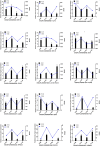Transcriptional Profiling Identifies Location-Specific and Breed-Specific Differentially Expressed Genes in Embryonic Myogenesis in Anas Platyrhynchos
- PMID: 26630129
- PMCID: PMC4667915
- DOI: 10.1371/journal.pone.0143378
Transcriptional Profiling Identifies Location-Specific and Breed-Specific Differentially Expressed Genes in Embryonic Myogenesis in Anas Platyrhynchos
Abstract
Skeletal muscle growth and development are highly orchestrated processes involving significant changes in gene expressions. Differences in the location-specific and breed-specific genes and pathways involved have important implications for meat productions and meat quality. Here, RNA-Seq was performed to identify differences in the muscle deposition between two muscle locations and two duck breeds for functional genomics studies. To achieve those goals, skeletal muscle samples were collected from the leg muscle (LM) and the pectoral muscle (PM) of two genetically different duck breeds, Heiwu duck (H) and Peking duck (P), at embryonic 15 days. Functional genomics studies were performed in two experiments: Experiment 1 directly compared the location-specific genes between PM and LM, and Experiment 2 compared the two breeds (H and P) at the same developmental stage (embryonic 15 days). Almost 13 million clean reads were generated using Illumina technology (Novogene, Beijing, China) on each library, and more than 70% of the reads mapped to the Peking duck (Anas platyrhynchos) genome. A total of 168 genes were differentially expressed between the two locations analyzed in Experiment 1, whereas only 8 genes were differentially expressed when comparing the same location between two breeds in Experiment 2. Gene Ontology (GO) and the Kyoto Encyclopedia of Genes and Genomes pathways (KEGG) were used to functionally annotate DEGs (differentially expression genes). The DEGs identified in Experiment 1 were mainly involved in focal adhesion, the PI3K-Akt signaling pathway and ECM-receptor interaction pathways (corrected P-value<0.05). In Experiment 2, the DEGs were associated with only the ribosome signaling pathway (corrected P-value<0.05). In addition, quantitative real-time PCR was used to confirm 15 of the differentially expressed genes originally detected by RNA-Seq. A comparative transcript analysis of the leg and pectoral muscles of two duck breeds not only improves our understanding of the location-specific and breed-specific genes and pathways but also provides some candidate molecular targets for increasing muscle products and meat quality by genetic control.
Conflict of interest statement
Figures




Similar articles
-
Deep RNA sequencing of pectoralis muscle transcriptomes during late-term embryonic to neonatal development in indigenous Chinese duck breeds.PLoS One. 2017 Aug 3;12(8):e0180403. doi: 10.1371/journal.pone.0180403. eCollection 2017. PLoS One. 2017. PMID: 28771592 Free PMC article.
-
MyoD and Myf6 gene expression patterns in skeletal muscle during embryonic and posthatch development in the domestic duck (Anas platyrhynchos domestica).J Anim Breed Genet. 2014 Jun;131(3):194-201. doi: 10.1111/jbg.12057. Epub 2013 Nov 4. J Anim Breed Genet. 2014. PMID: 24180358
-
Development of skeletal muscle and expression of myogenic regulatory factors during embryonic development in Jinding ducks (Anas platyrhynchos domestica).Poult Sci. 2014 May;93(5):1211-6. doi: 10.3382/ps.2013-03695. Poult Sci. 2014. PMID: 24795314
-
Skeletal Muscle Transcriptome Analysis of Hanzhong Ma Duck at Different Growth Stages Using RNA-Seq.Biomolecules. 2021 Feb 19;11(2):315. doi: 10.3390/biom11020315. Biomolecules. 2021. PMID: 33669581 Free PMC article.
-
Meeting the meat: delineating the molecular machinery of muscle development.J Anim Sci Technol. 2016 May 10;58:18. doi: 10.1186/s40781-016-0100-x. eCollection 2016. J Anim Sci Technol. 2016. PMID: 27168943 Free PMC article. Review.
Cited by
-
Transcriptome Profiling Identifies Differentially Expressed Genes in Skeletal Muscle Development in Native Chinese Ducks.Genes (Basel). 2023 Dec 28;15(1):52. doi: 10.3390/genes15010052. Genes (Basel). 2023. PMID: 38254942 Free PMC article.
-
MdVQ37 overexpression reduces basal thermotolerance in transgenic apple by affecting transcription factor activity and salicylic acid homeostasis.Hortic Res. 2021 Oct 1;8(1):220. doi: 10.1038/s41438-021-00655-3. Hortic Res. 2021. PMID: 34593787 Free PMC article.
-
RNA-Seq transcriptome analysis of breast muscle in Pekin ducks supplemented with the dietary probiotic Clostridium butyricum.BMC Genomics. 2018 Nov 28;19(1):844. doi: 10.1186/s12864-018-5261-1. BMC Genomics. 2018. PMID: 30486769 Free PMC article.
-
Deep RNA sequencing of pectoralis muscle transcriptomes during late-term embryonic to neonatal development in indigenous Chinese duck breeds.PLoS One. 2017 Aug 3;12(8):e0180403. doi: 10.1371/journal.pone.0180403. eCollection 2017. PLoS One. 2017. PMID: 28771592 Free PMC article.
-
Oxidative and glycolytic skeletal muscles show marked differences in gene expression profile in Chinese Qingyuan partridge chickens.PLoS One. 2017 Aug 16;12(8):e0183118. doi: 10.1371/journal.pone.0183118. eCollection 2017. PLoS One. 2017. PMID: 28813489 Free PMC article.
References
-
- van der Ven PF, Jap PH, Wetzels RH, ter Laak HJ, Ramaekers F, Stadhouders AM, et al. Postnatal centralization of muscle fibre nuclei in centronuclear myopathy. Neuromuscular disorders. 1991, 1(3):211–220. - PubMed
-
- Schiaffino S, Bormioli SP, Aloisi M. The fate of newly formed satellite cells during compensatory muscle hypertrophy. Virchows Archiv B. 1976, 21(1):113–118. - PubMed
-
- Kadi F, Charifi N, Denis C, Lexell J, Andersen JL, Schjerling P, et al. The behaviour of satellite cells in response to exercise: what have we learned from human studies? Pflügers Archiv. 2005, 451(2):319–327. - PubMed
-
- Li P, Akimoto T, Zhang M, Williams RS, Yan Z. Resident stem cells are not required for exercise-induced fiber-type switching and angiogenesis but are necessary for activity-dependent muscle growth. American Journal of Physiology-Cell Physiology. 2006, 290(6):C1461–C1468. - PubMed
Publication types
MeSH terms
LinkOut - more resources
Full Text Sources
Other Literature Sources

